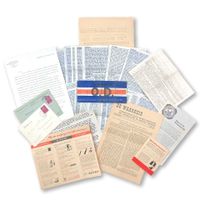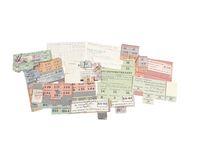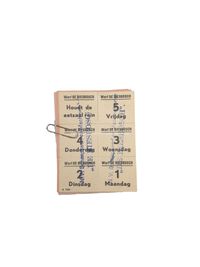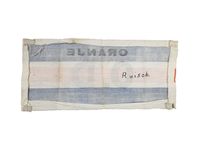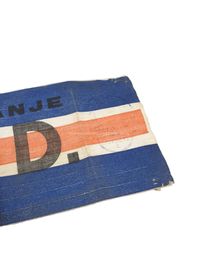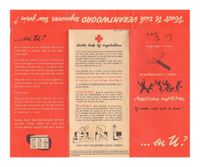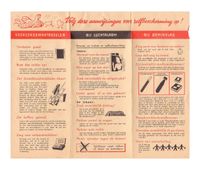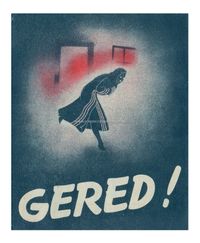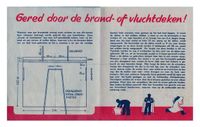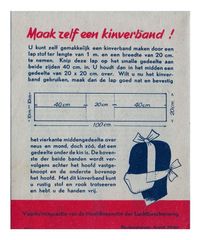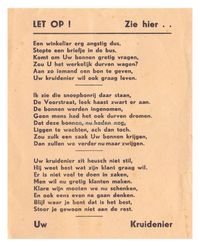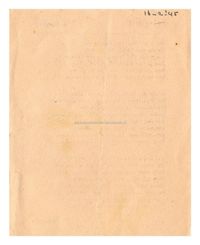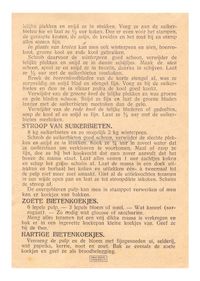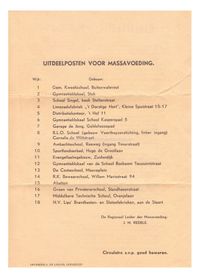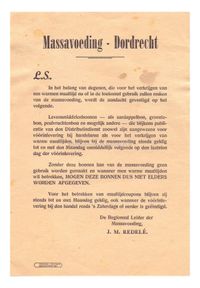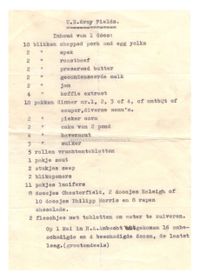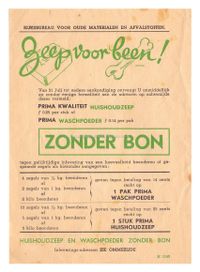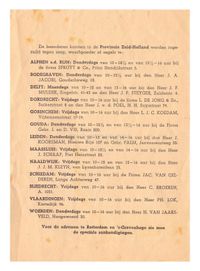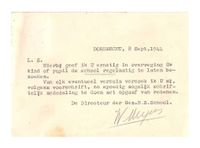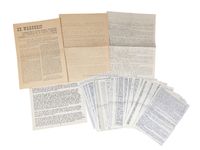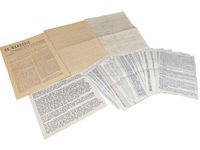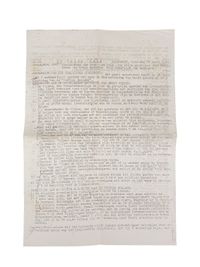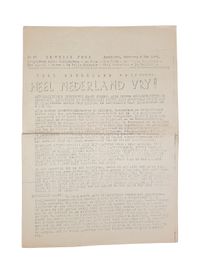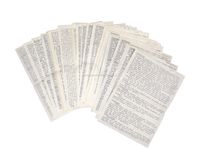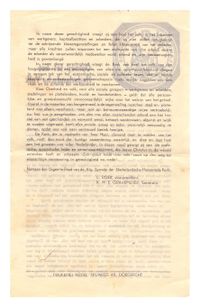The W.F. Ruisch set of items.
Below is a set of items formerly owned by Mr. W.F. Ruisch. He was a resident of the Boeroestraat in Dordrecht during the war and officially joined the Guard Troops ( Bewakingstroepen ) of the Domestic Armed Forces ( Binnenlandse Strijdkrachten ) in Dordrecht on May 8, 1945. The set is extensive, including a large number of ration coupons, resistance newspapers, an Ordedienst armband with his name on it, mass food distribution documents, and other documents. It is suspected that Mr. Ruisch was already a member of the Ordedienst during the war and officially joined the Guard Troops of the Domestic Armed Forces after the war. (Region South-Holland-Zuid, District 6 Dordrecht B.T.)
Firstly, part of the set includes a box from the Victoria factory. The box is filled to the brim with partially used ration coupons. It is unlikely that such a large quantity of coupons belonged to one person. This could indicate that Mr. Ruisch was involved in hiding and supporting individuals in hiding (underground work), as it strongly suggests his involvement in an illegal organization during the war. The coupons may have been used for distributing to individuals in hiding.
Below you can see a number of overview photos of what is included in the set. (Click on the photos to enlarge them.)
Ration coupons and food coupons.
First, we have a collection of coupons. Among the items, we see a box from the Victoria factory, presumably an old cookie tin. The box is filled to the brim with ration coupons, almost all of them used. It strongly suggests that these coupons were used for distribution among hiding individuals. It appears that there were simply too many for just one family.
In the box, there are also several documents with names on them. These include a national distribution card, notably not in the name of Mr. Ruisch but in the name of someone named J.G. v Buul. There is also a fuel coupon card in Mr. Ruisch's name, a family card for fruits and vegetables, and various handwritten sheets detailing food items for specific periods. Additionally, there are snippets of newspaper clippings with the same information.
(Click on the photos to enlarge.)
"Ordedienst" Armband.
The following photos are of the armband of the Ordedienst Dordrecht, a resitance organisation during the war. The name "Ruisch" is written on the back. The Ordedienst was established in August 1940 through the merger of various illegal organizations. Initially, the organization primarily consisted of former military personnel. It was created with the purpose of maintaining order and facilitating the smooth return of the Dutch government in the event that the Germans would leave the Netherlands, creating a power vacuum. However, this did not happen as the war lasted longer than expected.
During the course of the war, the Ordedienst became increasingly involved in resistance activities, such as sabotage and gathering intelligence to be sent to England. By around 1943, the Ordedienst had been weakened significantly due to arrests and many ex-military members being taken as prisoners of war again. Under the leadership of the new head of the national Ordedienst organization, sabotage activities were halted, and the focus shifted to gathering intelligence and maintaining order for when liberation would come.
In October 1944, like all illegal organizations, the Ordedienst merged into the National Binnenlandse Strijdkrachten (NBS). After consulting archives, it can be concluded that Mr. Ruisch was likely not a former military member. If we assume that the armband belonged to him during the war, he was probably a civilian who later joined the Ordedienst. Although there is no specific information about his Ordedienst past in the archives, that does not necessarily mean he wasn't part of the Ordedienst. It is difficult to say for certain.
The armband is in the typical colors of Orange Netherlands and is characterized by the letters "O.D." The faint stamp of Dordrecht can be seen on the right side of the armband. Various types of armbands were used during the war. (Click on the photos for enlargement.) *1
Information Posters Air Protection Service.
Below we see two information posters issued by the Air Protection Service. During the war, the sight of airplanes flying overhead was a familiar image for every Dutch person. The Allies also frequently bombed targets in the Netherlands. Even before the war, air protection services were present throughout the country. These services consisted of volunteers who had various tasks, including firefighting, first aid, and managing shelter spaces. During the war, the Air Protection Service was significantly expanded by the occupying forces, due to the increasing number of bombings by the Allies. Dordrecht was not exempted from these bombings. The most well-known example is the bombing of Park Merwestein and the surrounding streets. While a large German headquarters was located there, the casualties included not only among the Germans but also civilians. The information poster below is an example of how the Air Protection Service provided information to citizens on what to do during a bombing. (Click on the photos to enlarge) *2
Food Supply in Dordrecht.
Below are various items related to food supply. Resistance groups used couriers to distribute printed messages, hoping to obtain ration coupons which they could then use to feed people in hiding. The document from the "Kruidenier" ( Grocer ) is likely an example of this. The date "16 February 1945" is written on the back, right in the middle of the hunger winter that also affected Dordrecht, which was still not liberated. The sugar beet recipe is also an interesting document. As basic food items were scarce during the hunger winter, people had to resort to eating unconventional things. The most well-known examples are sugar beets and tulip bulbs. This document provides information on how to prepare sugar beets. Then there is the"Massa voeding" document. ( Feeding the masses ) As the document explains, not everyone had the means to cook meals. Mass food distribution aimed to provide meals to Dordrecht residents who had nothing during the hunger winter. Community kitchens were established at various locations, as described on the back of the document. Finally, there is a document that lists the contents of a U.E. Dray Fields box. This document is likely related to Operation Manna. In April and May 1945, the Allies had made an agreement with the German occupiers to airdrop food supplies into occupied Netherlands. The situation was so severe that there was hardly any food or clothing available. The food drops in April and May of that year were therefore crucial for the Dutch population. (Click on the photos to enlarge)
Soap for bone!
Below we see another document which shows that the situation during the later stage of the war was severe. There was a scarcity of goods. This document provides information about turning in bones, which could be used to make soap. Through these kinds of makeshift solutions, people could make their daily lives a bit more bearable. (Click on the photos to enlarge.)
Letters from the municipal Higher Civilian School (H.B.S.) in Dordrecht.
Below are two letters from the municipal Higher Civilian School (H.B.S.) in Dordrecht. The letters are addressed to Mr. Ruisch. They were written by the school's principal, expressing concerns about high absence among students. This is not surprising, as many parents kept their children at home out of fear of raids by the occupying forces who would snatch up men of working age for forced labor. As a result, many students stopped coming to school. The letter also indicates that the principal was aware of this situation and instructs parents to report any absences to him. It is another example of how the war had an impact on daily life. (Click on the photos to enlarge.)
Resistance Newspapers/Illegal Newspapers.
Here we see a substantial collection of illegal resistance newspapers. Well-known names such as De Vrije Pers (The Free Press) and De Waarheid (The Truth) are present. These newspapers were often distributed by couriers of the resistance to keep people informed and break through the censorship imposed by German newspapers. Remarkable is the large stack of small resistance newspapers. These newspapers cover the period from March 1945 until May 4, 1945. There are also a number of loose newspapers. The newspapers from May 4 and 5, 1945, are particularly interesting. The liberation had become a reality! (Click on the photos to enlarge.)
Appeal to the Dutch People - Synod of the Dutch Reformed Church.
Finally, we see here a document from the Synod of the Dutch Reformed Church. It is a document about the liberation that has arrived. It is primarily an appeal to the good manners of people, to continue doing good and to be united even in times of liberation.
I have attempted to provide as much accurate information as possible for each item. Many are based on assumptions. This includes the assumption that Mr. Ruisch, due to the large number of ration coupons, resistance newspapers, other documents, and the Ordedienst armband in his possession, likely had some involvement with an illegal organization. It appears that Mr. Ruisch was involved in providing food for people in hiding. However, this is not certain.
Anyone who can provide me with additional information about any of the items shown above or about Mr. Ruisch's wartime past, please email me at: Info@dordrechtindeoorlog.nl
©2017-2024 :Https://www.Dordrechtindeoorlog.nl: ( There is a copyright on the content of this website. This content is not to be shared, duplicated or published withouth the explicit permission of the author of this website. If you have any requests you can email to: Info@Dordrechtindeoorlog.nl or look on : www.dordrechtindeoorlog.nl/termsofuseforthecontentonthiswebsite.
*1 Source: https://www.verzetsmuseum.org/Ordedienst.
*2 Source: https://www.verzetsmuseum.org/luchtbescherming.

